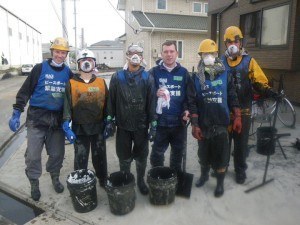Like this post? Help us by sharing it!
I recently completed seven days volunteer work with the Japan-based non-profit organization Peace Boat. I was part of an international group of 6 volunteers – British, Japanese, Irish and Vietnamese. Complete strangers at the start, the nature of our work and life in Ishinomaki brought us together. We barely lost sight of each other all week.
Our day started outside in the courtyard with rajio taiso, a slightly camp but addictive musical warm-up exercise. We shoveled sludge from 8-5, then washed our tools and work-clothing before re-entering the base. Most evenings we cooked and ate together. For the benefit of others, I helped with eating rather than cooking.
Our home for the week was a square of small plastic-covered tatami mats in the corner of Kasuka Fashion, a two storey building which is a base for Peace Boat relief operations in Ishinomaki. The base is just 1km from the sea, on the edge of a vulnerable flat bed of land that the tsunami swallowed up three months ago.
The homes around Kasuka have been affected in one of three ways: those completely washed away, those damaged but still standing, and those structurally unhurt but with hedoro (sludge washed in by the tsunami) piled up inside.

Our group specialized in removing this hedoro. Handling hedoro is a curious experience. It smells like seawater, can be toxic, and looks like dark chocolate mousse. Carefully avoiding the temptation to taste some, we shoveled it into sandbags which we took onto the road to await collection.
It was not always straightforward work. Hedoro is a stubborn elusive foe that lurks in every nook and cranny. We needed support. Peace Boat provided us with weapons to evict the unwelcome lodger. We used a koatsu hosu (high pressure hose), neko (wheelbarrows), baketsu (buckets), chiritori (dustpans), joren (a cross between a shovel and a scythe) and sukopu (shovels). In awkward areas, where none of these tools were suitable, we used our rubber-gloved hands.
In the house of the Endo family, hedoro had made a home amongst the pipes in a narrow culvert under the bathroom floor. Wearing a head torch, helmet, facemask, goggles and taped-up rain suit we took turns to wriggle in and clear it out. Nicknamed the SWAT job, it wasn`t a pleasant task, but it made for good photos and banter afterwards.

The six of us took us 5 full days to clear beneath the floor of two homes and from the garden of another. Our role was just one stage in the rehabilitation of these houses – professionals will have to complete the job. When you consider more than a 100,000 houses were damaged or destroyed by the tsunami, both professionals and volunteers will be needed for a long time.
Three months after the event, many parts of Ishinomaki still resemble a war-zone. It`s almost as if the tsunami happened just yesterday. In some areas, apart from the roads, little seems to have improved since March 11th. In no-go zones, the Self-Defence Force are still searching wreckage for bodies.
This snail-paced recovery is not down to tardiness, but because of the scale of the devastation. Estimates suggest that the earthquake moved the east coast of Japan 8 feet, while parts of Ishinomaki sank by over one metre. In a seaside town, this shift has serious consequences. At high tide, roads now become rivers, and some coastal residential areas may be declared uninhabitable.
![246979_10150193522782791_678602790_7393063_1882415_n[1]](https://www.insidejapantours.com/blog/wp-content/uploads/2011/06/246979_10150193522782791_678602790_7393063_1882415_n1.jpg)
The Endo family were gentle and kind to us, even though we were stomping around their home in filthy safety boots. They have been stuck on the 2nd floor for almost three months, effectively living above a bog.
The father works while the mother looks after their young children, any free moments are spent cleaning their home. Removing the toxic hedoro in a relatively short space of time, we were able to make a real difference to their quality of life. It felt like we had helped them take a step back up a ladder they had been pushed off.
To show their gratitude, Mrs Endo regularly handed out sweet snacks. This was appreciated. It confirmed we were welcome guests, and more importantly, it took away the nauseating aftertaste of my cheese-filled fish sausage packed lunch.
On my final morning, before I boarded the bus back to Tokyo, a leading volunteer shook my hand and said “Hope to see you again”. He`s not going home for a while, and neither is Peace Boat. Manpower is still desperately needed in Ishinomaki, so much so that Peace Boat is now accepting volunteers for two-days. The job has only just started.



